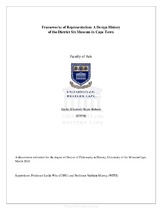| dc.description.abstract | Since 1994, the District Six Museum, in constructing histories of forced removals from District Six,
Cape Town, commenced as a post-apartheid memory project which evolved into a memorial museum.
Design has been a central strategy claimed by the museum in its process of making memory work
visible to its attendant publics evolving into a South African cultural brand. Co-design within the
museum is aesthetically infused with sensitively curated exhibitions and a form of museumisation,
across two tangible sites of engagement, which imparts a unique visual language. The term design
became extraordinarily popular in contemporary Cape Town, where the city was - in 2014 -the World
Design Capital. Yet at the same time as design was being inscribed into the public imaginary, it was
simultaneously curiously undefined although influential in shifting representational aesthetics in the
city. This research seeks to ask questions about this proliferation of interest in design and to examine
this through a close reading of the work of the District Six Museum situated near District Six. In
particular, micro and macro design elements are explored as socio-cultural practice in re-imagining
community in the city that grew out of resistance and cultural networks. Various design strategies or
frameworks of representation sought to stabilize and clarify individual and collective pasts enabling
and supporting ex-residents to reinterpret space after loss, displacement and separation and re-enter
their histories and the city. Post-apartheid museum design modes and methodologies applied by the
District Six Museum as museumisation disrupts conventional historiographies in the fields of art,
architectural and exhibition design, where the focus is placed on temporal chronologies, in a biographic
mode profiling examples of works and designers/artists. Instead, the research contextualises the work
of design as making in a more open sense, of exploring the very constructedness of the museum as a
space of method, selection, process and representation thereby asking questions about this reified term
design as method and practice. The designing ways of the District Six Museum contribute to
understanding idioms mediated through design frameworks allowing for a departure from the limited
ways design history has been written. Through an unlayering of projects, practices and an examination
of archival case studies, exhibition curation, the adaptive reuse of buildings and through institutional
rebranding my argument is that the particularities of the claims to design work at the District Six
Museum provide a rich case for relating to other contemporaneous processes of making apartheid’s
spatial practices visible as projects such as this claim community. Therefore seeking to demystify how
this community museum ‘making’ has been fashioned through an investment in various design
disciplines, forms and practices revealing the inherent complexity in doing so. | en_US |

